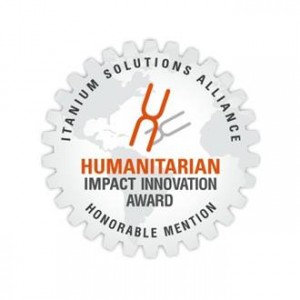 2018/09/06 | Registration Open for the Third Spring School on Lattice Boltzmann Methods with OpenLB Software Lab. Registration is now open for the spring school Lattice Boltzmann Methods with OpenLB Software Lab that will be held in Mannheim, Germany, from 18. to 22. of February 2019. The spring school introduces scientists and applicants from industry to the theory of LBM and trains them on practical problems. The first half of the week is dedicated to the theoretical fundamentals of LBM up to ongoing research on selected topics. Followed by mentored training on case studies using OpenLB in the second half, where the participants gain deep insights into LBM and its applications. This educational concept is probably unique in the LBM community and offers a comprehensive and personal guided approach to LBM. Participants also benefit from the knowledge exchange during poster session, coffee breaks and the excursion. We look forward to your participation.
2018/09/06 | Registration Open for the Third Spring School on Lattice Boltzmann Methods with OpenLB Software Lab. Registration is now open for the spring school Lattice Boltzmann Methods with OpenLB Software Lab that will be held in Mannheim, Germany, from 18. to 22. of February 2019. The spring school introduces scientists and applicants from industry to the theory of LBM and trains them on practical problems. The first half of the week is dedicated to the theoretical fundamentals of LBM up to ongoing research on selected topics. Followed by mentored training on case studies using OpenLB in the second half, where the participants gain deep insights into LBM and its applications. This educational concept is probably unique in the LBM community and offers a comprehensive and personal guided approach to LBM. Participants also benefit from the knowledge exchange during poster session, coffee breaks and the excursion. We look forward to your participation.
Mind that the number of participants is limited and that the registration follows a first come first serve principle.
Registration: https://www.openlb.net/spring-school-registration
More information: https://www.openlb.net/spring-school-2019
On behalf of the spring school executive committee, Natascha Heß-Mohr, Mathias J. Krause, Matthias Rädle, Robin Trunk.
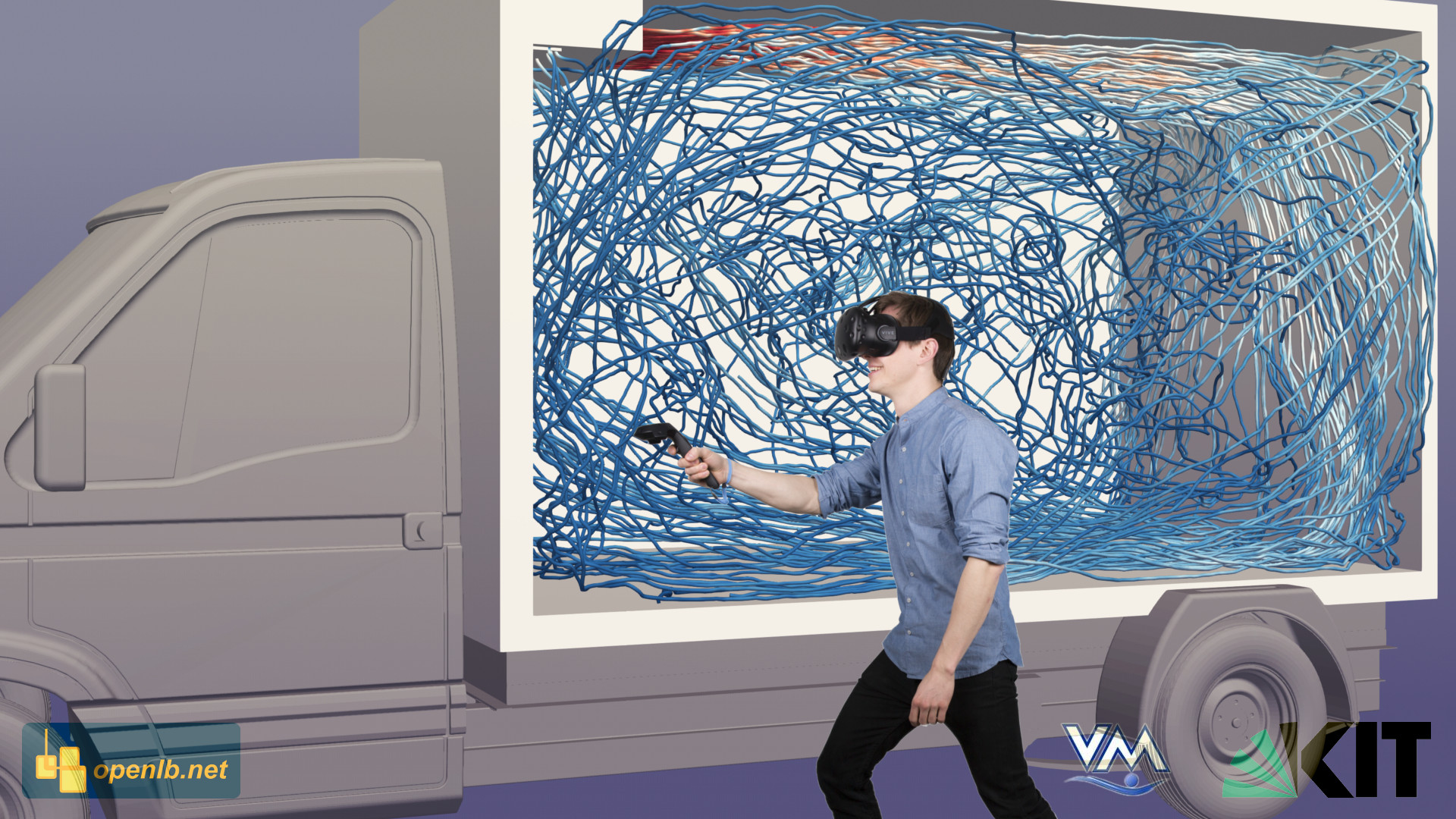 2018/04/26 | OpenLB at Achema 2018, Frankfurt Germany (June 11th to 15th, Hall 9.2 A80). A Virtual Reality (VR) approach for process engineering applications shows OpenLB’s latest simulation results. The image shows a thermal LES simulation of the air flow in a refrigerated truck. In the VR presentation an observer can explore the data in a virtual reality with his VR glasses and controller. Find out more in the show case section.
2018/04/26 | OpenLB at Achema 2018, Frankfurt Germany (June 11th to 15th, Hall 9.2 A80). A Virtual Reality (VR) approach for process engineering applications shows OpenLB’s latest simulation results. The image shows a thermal LES simulation of the air flow in a refrigerated truck. In the VR presentation an observer can explore the data in a virtual reality with his VR glasses and controller. Find out more in the show case section.

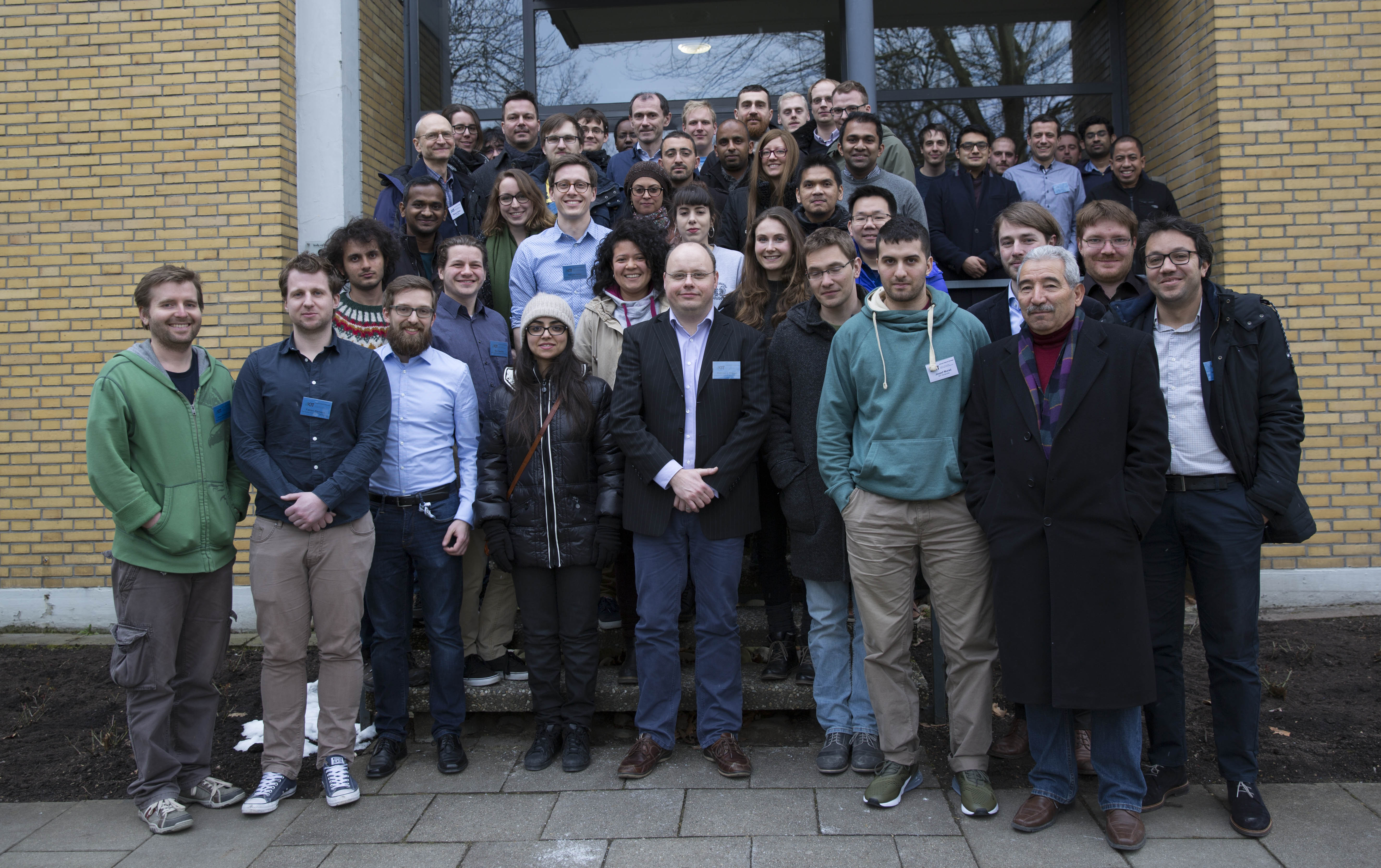 2018/03/23 | LBM Spring School with OpenLB Software Lab successfully finished. The executive committee announces the closing of the second LBM Spring School with OpenLB Software Lab. We were happy to host 49 participants from 14 countries and 4 continents, including five invited speakers in Karlsruhe, Germany.
2018/03/23 | LBM Spring School with OpenLB Software Lab successfully finished. The executive committee announces the closing of the second LBM Spring School with OpenLB Software Lab. We were happy to host 49 participants from 14 countries and 4 continents, including five invited speakers in Karlsruhe, Germany.
This year’s poster award goes to Juliana García Sarmiento from the National University of Colombia, Bogotá.
On behalf of the spring school executive committee, Ezeddine Sediki, Mathias J. Krause, Mahdi Tekitek, Albert Mink.
2018/01/03 | Running OpenLB on Windows 10 in few minutes. A new video has been uploaded by FetchCFD explaining how to install OpenLB on Windows 10 unsing Ubuntu Bash. Please, also check out our Tech Report on how to install OpenLB on Windows 10’s Ubuntu Bash has been contributed by Jesse. It enables using OpenLB on Windows 10 platforms in a few minutes. It is available for download.
 2018/02/19 | Release 1.2 Available. The OpenLB developer team is very happy to announce that a new release of the open source Lattice Boltzmann Method (LBM) code is available for download as well as a new doxygen documentation. Have a look and be excited!
2018/02/19 | Release 1.2 Available. The OpenLB developer team is very happy to announce that a new release of the open source Lattice Boltzmann Method (LBM) code is available for download as well as a new doxygen documentation. Have a look and be excited!
The new features and interfaces are:
- New user-friendly features:
- Simplified converter from and to lattice units
- New gnuplot based plotting functionality
- New WALE-based turbulence model
- New inflow profiles for non-Newtonian fluids and turbulent pipe flows
- New 3D finite difference turbulence functors
- New examples:
- poiseuille3d
- thermal/thermalPorousPlate2d and thermal/thermalPorousPlate3d
- thermal/squareCavity2d and thermal/squareCavity3d
- Minor improvements and developer notes:
- New faster parallel build system
- New integral functors
- Bugs fixed in e.g. functors, slip boundary condition
- Removed the 231 grid point limit
- All examples updated
- Compatibility tested on MacOS X clang 800.0.38, Windows Cygwin gcc 4.8, Windows 10 Ubuntu bash gcc 4.8, Linux with gcc 4.8 and higher, clang 3.6 and higher and Intel 15.0 and higher, OpenMPI 1.8 and higher, Intel MPI 5.0 and higher
PS: Please consider to join the developer team, by contributing your code and strengthen the LB community by sharing your research in an open and reproducible way!
 2017/09/13 | Registration Open for the Second Spring School on Lattice Boltzmann Methods with OpenLB Software Lab. Registration is now open for the spring school Lattice Boltzmann Methods with OpenLB Software Lab that will be held in Karlsruhe, Germany, from 19. to 23. March 2018. The spring school introduces scientists and applicants from industry to the theory of LBM and trains them on practical problems. The first half of the week is dedicated to the theoretical fundamentals of LBM up to ongoing research on selected topics. Followed by mentored training on case studies using OpenLB in the second half, where the participants gain deep insights into LBM and its applications. This educational concept is probably unique in the LBM community and offers a comprehensive and personal guided approach to LBM. Participants also benefit from the knowledge exchange during poster session, coffee breaks and the excursion. We look forward to your participation.
2017/09/13 | Registration Open for the Second Spring School on Lattice Boltzmann Methods with OpenLB Software Lab. Registration is now open for the spring school Lattice Boltzmann Methods with OpenLB Software Lab that will be held in Karlsruhe, Germany, from 19. to 23. March 2018. The spring school introduces scientists and applicants from industry to the theory of LBM and trains them on practical problems. The first half of the week is dedicated to the theoretical fundamentals of LBM up to ongoing research on selected topics. Followed by mentored training on case studies using OpenLB in the second half, where the participants gain deep insights into LBM and its applications. This educational concept is probably unique in the LBM community and offers a comprehensive and personal guided approach to LBM. Participants also benefit from the knowledge exchange during poster session, coffee breaks and the excursion. We look forward to your participation.
Mind that the number of participants is limited and that the registration follows a first come first serve principle.
Registration: https://www.openlb.net/spring-school-registration
More information: https://www.openlb.net/spring-school-2018
On behalf of the spring school executive committee, Ezeddine Sediki, Mathias J. Krause, Mahdi Tekitek, Albert Mink.
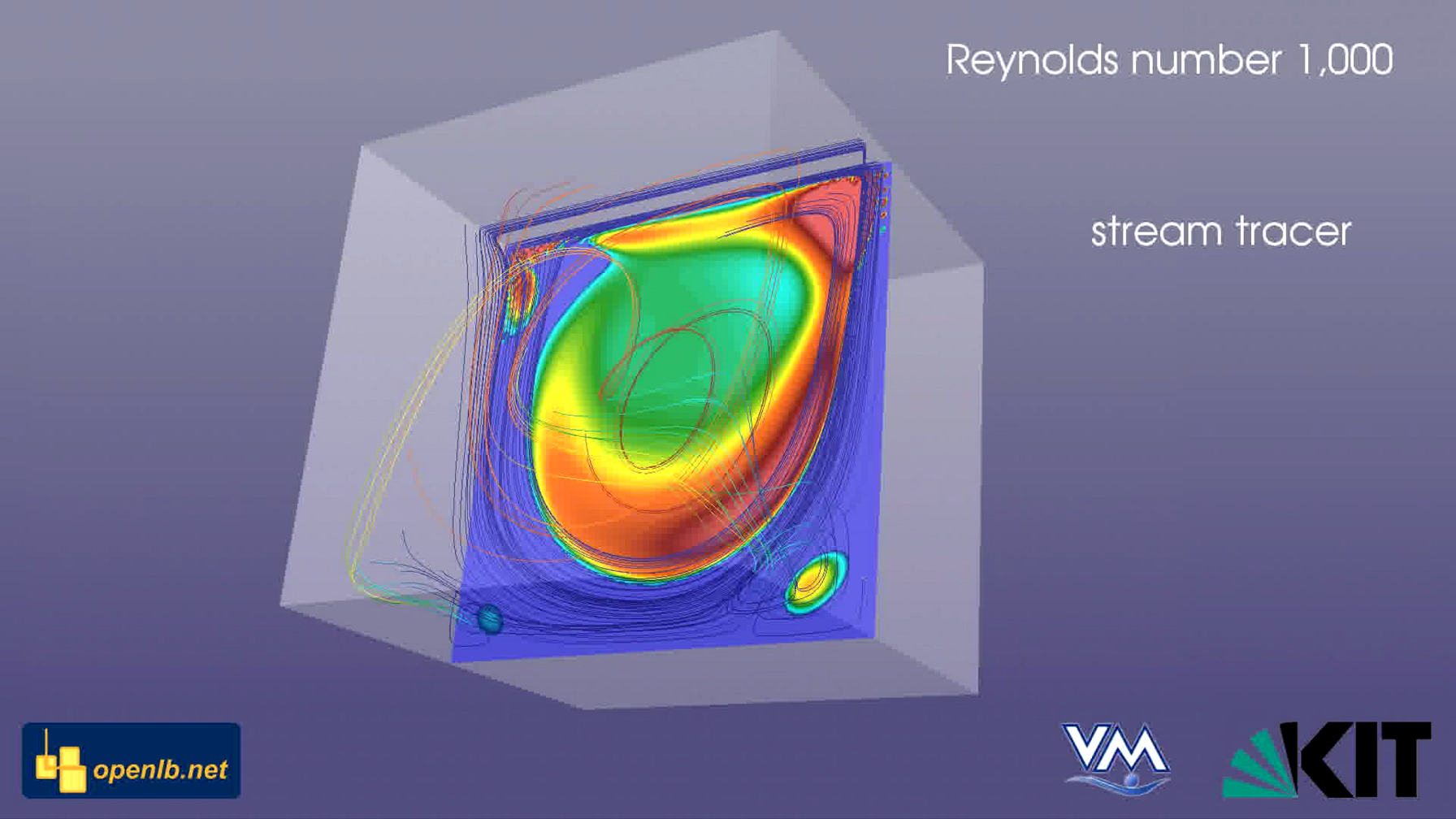 2017/06/07 | OpenLB Community YouTube Channel Update. A new video shows the results of a famous benchmark problem in CFD. The lid driven cavity problem illustrates a flow in a cuboid. The top wall moves from left to right with a constant velocity, while the other walls are fixed. The fundamental feature of this often studied fluid flow problem is the formation of a large primary vortex in the center and two smaler vortices near the two lower edges. Different techniques are applied to visualize the fluid flow including the vortices with the cavity. The source code of this simulations can be found in the examples section of the latest release of OpenLB. You will find more information in our show case section.
2017/06/07 | OpenLB Community YouTube Channel Update. A new video shows the results of a famous benchmark problem in CFD. The lid driven cavity problem illustrates a flow in a cuboid. The top wall moves from left to right with a constant velocity, while the other walls are fixed. The fundamental feature of this often studied fluid flow problem is the formation of a large primary vortex in the center and two smaler vortices near the two lower edges. Different techniques are applied to visualize the fluid flow including the vortices with the cavity. The source code of this simulations can be found in the examples section of the latest release of OpenLB. You will find more information in our show case section.
If you have a nice video which you have obtained with OpenLB, please let us know and we will link it or upload it. Please contact us.
2017/04/27 | Running OpenLB on Windows 10 in few minutes. A new Tech Report on how to install OpenLB on Windows 10’s Ubuntu Bash has been contributed by Jesse. It enables using OpenLB on Windows 10 platforms in a few minutes. It is available for download.
 2017/04/12 | Release 1.1 Available. The OpenLB developer team is very happy to announce that a new release of the open source Lattice Boltzmann Method (LBM) code is available for download as well as a new doxygen documentation. Have a look and be excited!
2017/04/12 | Release 1.1 Available. The OpenLB developer team is very happy to announce that a new release of the open source Lattice Boltzmann Method (LBM) code is available for download as well as a new doxygen documentation. Have a look and be excited!
The new features and interfaces are:
- New user-friendly features:
- Generation of real-time plots of simulation data, realized with Gnuplot (see examples cylinder2d, cavity2d and tgv3d)
- Implementation of plot over line feature to get characteristic data (see example cavity3d)
- Convergence check for steady state (see examples cavity2d and cavity3d)
- Introduced zLib compression to reduce size of VTK data
- Implemented Hertz-Mindlin forces for particulate flows
- New 3D slip boundary condition
- Performance improvements:
- Speed-up of about 20 percent using vector instruction sets of modern compilers
- Minor improvements and developer notes:
- Included zLib library for VTK data compression
- Updated VTK format from pvd to vtm for single time steps
- Efficiency improvements of all functors
- Fixed bug with GifWriter
- Improved implementation of turbulence models (e.g. Smagorinsky, see examples tgv3d and nozzle3d)
- Removed several memory leaks
- Moving towards C++11
- All examples updated
- Compatibility tested on MacOS X clang 800.0.38, Windows Cygwin gcc 4.9, Windows 10 Ubuntu bash gcc 4.8, Linux with gcc 4.8 and higher, clang 3.6 and higher and Intel 14.0 and higher, OpenMPI 1.8 and higher, Intel MPI 5.0 and higher
PS: Please consider to join the developer team, by contributing your code and strengthen the LB community by sharing your research in an open and reproducible way!

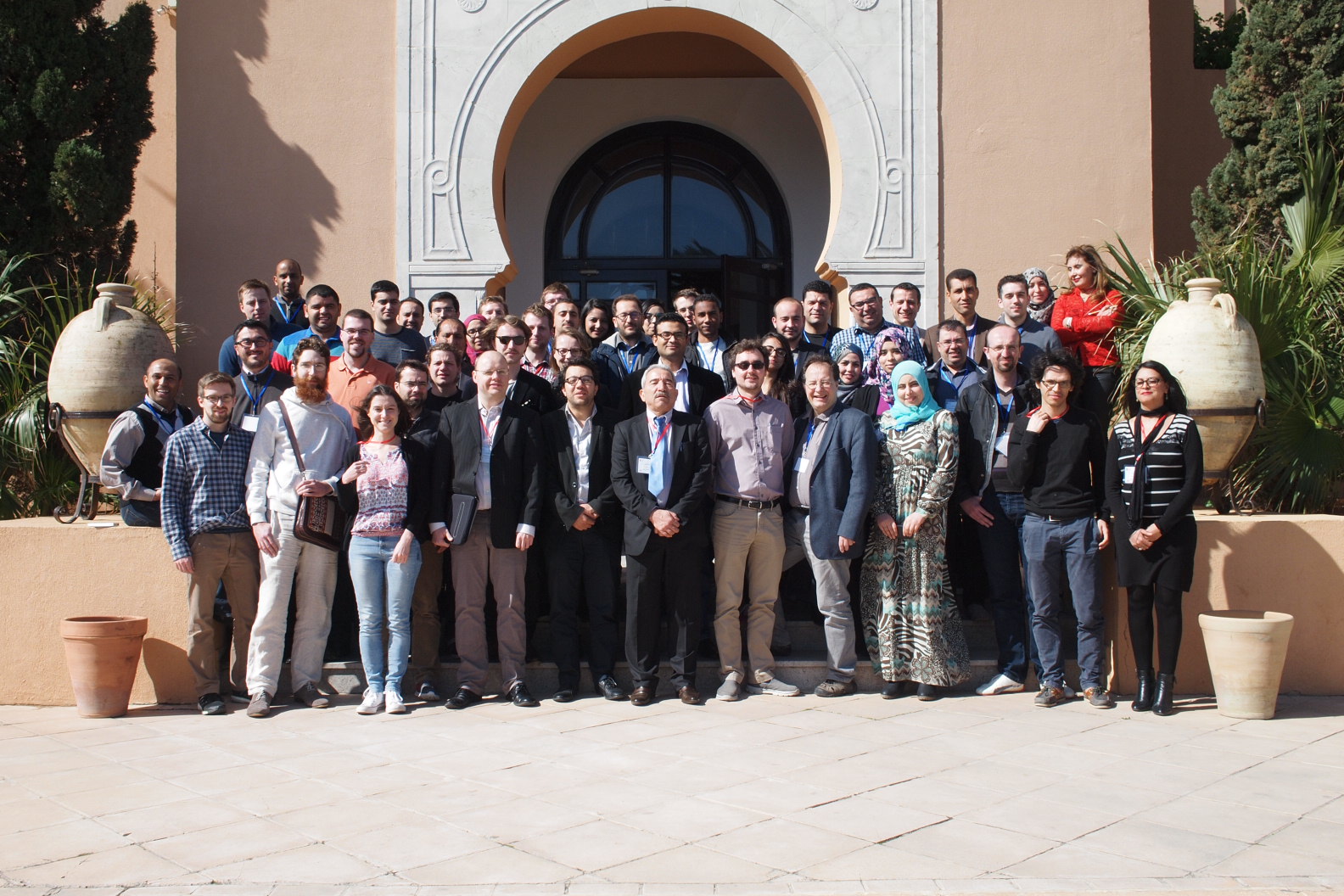 2017/03/10 | LBM Spring School with OpenLB Software Lab successfully finished. The executive committee announces the closing of the first LBM Spring School with OpenLB Software Lab. We were happy to host 64 participants from 10 countries, including four invited speakers in Hammamet Tunisia.
2017/03/10 | LBM Spring School with OpenLB Software Lab successfully finished. The executive committee announces the closing of the first LBM Spring School with OpenLB Software Lab. We were happy to host 64 participants from 10 countries, including four invited speakers in Hammamet Tunisia.
Ridha DJEBALI quoted: “I would like to thank you, your team and all the participants in this LBM training where they shared with us their experiences. The Tunisian participants were impressed by the quality of the teamwork you have shown and your young researchers, cool, cooperative was endowed with patience as it is necessary for hard days of work and have honoured the institute KIT.”
On behalf of the spring school executive committee, Ezeddine Sediki, Mathias J. Krause, Mahdi Tekitek, Albert Mink.
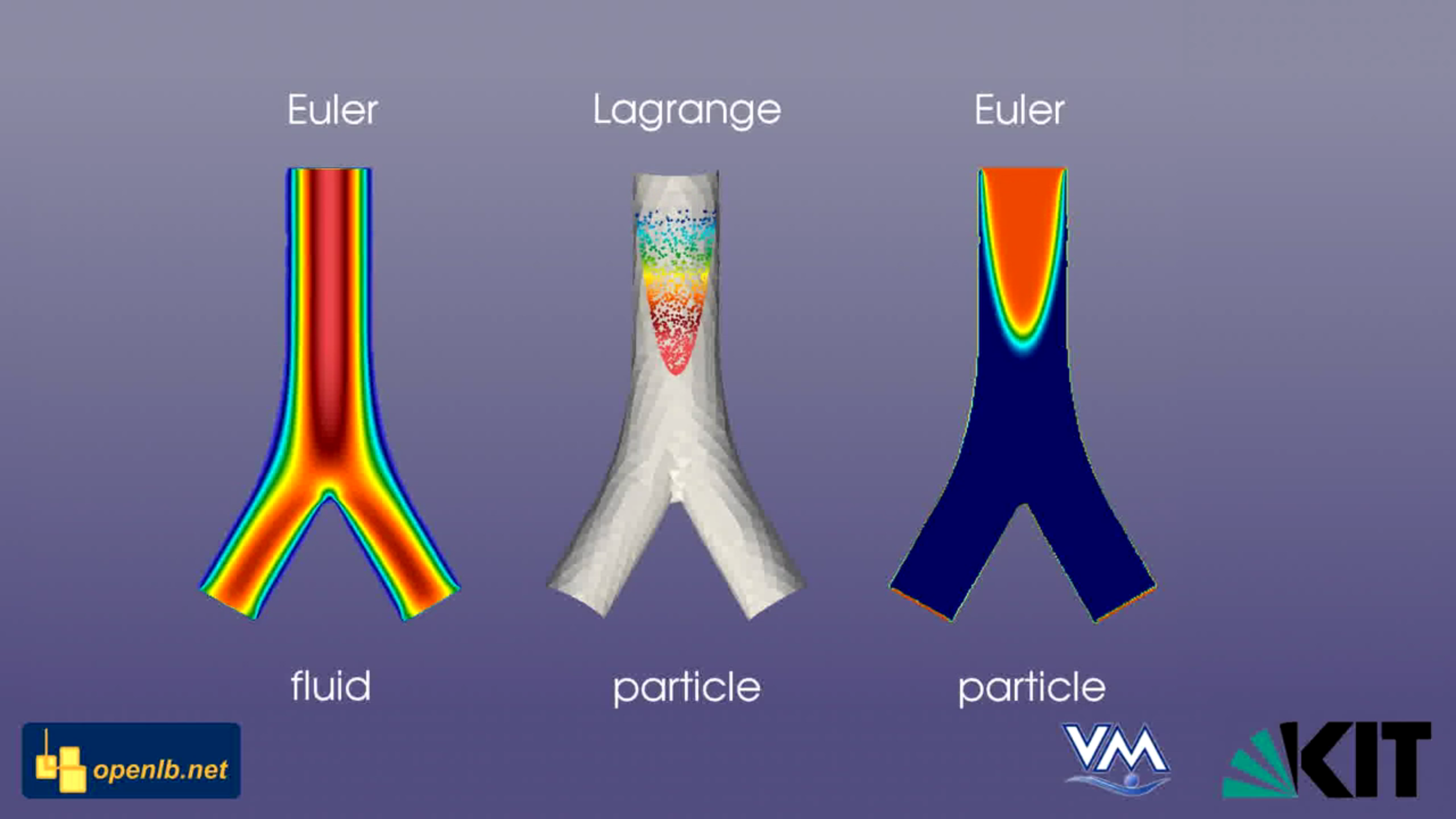 2017/03/02 | OpenLB Community YouTube Channel Update. A new video shows the results of two approaches for the simulation of particulate fluid flows, one is based on an Euler-Euler and the other on an Euler-Lagrange model. Both approaches are tested on a benchmark problem, where the deposition rates are computed in a bifurcation for given particle sizes. They yield the same results but differ in efficiency regarding the field of application. The source code of this simulations can be found in the examples section of the latest release of OpenLB. You will find more information in our show case section.
2017/03/02 | OpenLB Community YouTube Channel Update. A new video shows the results of two approaches for the simulation of particulate fluid flows, one is based on an Euler-Euler and the other on an Euler-Lagrange model. Both approaches are tested on a benchmark problem, where the deposition rates are computed in a bifurcation for given particle sizes. They yield the same results but differ in efficiency regarding the field of application. The source code of this simulations can be found in the examples section of the latest release of OpenLB. You will find more information in our show case section.
If you have a nice video which you have obtained with OpenLB, please let us know and we will link it or upload it. Please contact us.
 2016/09/15 | Registration Open for First Spring School on Lattice Boltzmann Methods with OpenLB Software Lab. Registration is now open for the spring school Lattice Boltzmann Methods with OpenLB Software Lab that will be held in Hammamet, Tunisia, from 6. to 10. March 2017. The spring school introduces scientists and applicants from industry to the theory of LBM and trains them on practical problems. The first three days are dedicated to the theoretical fundamentals of LBM up to ongoing research on selected topics. Followed by two days of mentored training on case studies using OpenLB, the participants gain deep inside into LBM and its applications. This educational concept is probably unique in the LBM community and offers a comprehensive and personal guided approach to LBM. Participants also benefit from the knowledge exchange during poster session, coffee breaks and the excursion at the Mediterranean sea. We look forward to your participation.
2016/09/15 | Registration Open for First Spring School on Lattice Boltzmann Methods with OpenLB Software Lab. Registration is now open for the spring school Lattice Boltzmann Methods with OpenLB Software Lab that will be held in Hammamet, Tunisia, from 6. to 10. March 2017. The spring school introduces scientists and applicants from industry to the theory of LBM and trains them on practical problems. The first three days are dedicated to the theoretical fundamentals of LBM up to ongoing research on selected topics. Followed by two days of mentored training on case studies using OpenLB, the participants gain deep inside into LBM and its applications. This educational concept is probably unique in the LBM community and offers a comprehensive and personal guided approach to LBM. Participants also benefit from the knowledge exchange during poster session, coffee breaks and the excursion at the Mediterranean sea. We look forward to your participation.
Registration: https://www.openlb.net/spring-school-registration
More information: https://www.openlb.net/spring-school-2017
On behalf of the spring school executive committee, Ezeddine Sediki, Mathias J. Krause, Mahdi Tekitek, Albert Mink.
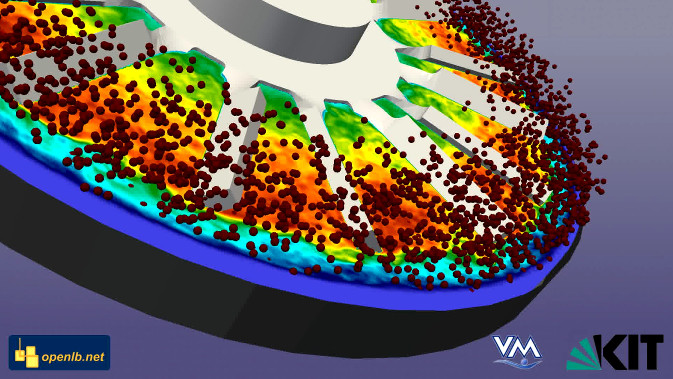 2016/06/09 | OpenLB Community YouTube Channel Update. A new video shows the highly turbulent particulate fluid flow in a dynamic cross-flow device, simulated with a DEM-LB model on a high performance cluster unsing OpenLB. Together with the fluid, the particle enter the geometry at a small inlet at the top. They are filtered by a membrane at the bottom. You will find this example in our show case section.
2016/06/09 | OpenLB Community YouTube Channel Update. A new video shows the highly turbulent particulate fluid flow in a dynamic cross-flow device, simulated with a DEM-LB model on a high performance cluster unsing OpenLB. Together with the fluid, the particle enter the geometry at a small inlet at the top. They are filtered by a membrane at the bottom. You will find this example in our show case section.
If you have a nice video which you have obtained with OpenLB, please let us know and we will link it or upload it. Please contact us.
2016/05/12 | Introduction to Particulate Flow Simulations. A three day course in GERMAN LANGUAGE is held in Karlsruhe from the 28th to 30th of September 2016. In addition to a theoretical introduction, one full day is dedicated to Lattice Boltzmann Methods and OpenLB. Please check out the program for more information.
 2016/03/10 | Release 1.0 Available. The OpenLB developer team is very happy to announce that a new release of the open source Lattice Boltzmann Method (LBM) code is available for download as well as a new user guide and new doxygen documentation. New examples and models for particulate fluid flow simulations and many user-friendly interfaces have been added. The performance of standard 3D models has been improved by up to 30 percent. Have a look and be excited!
2016/03/10 | Release 1.0 Available. The OpenLB developer team is very happy to announce that a new release of the open source Lattice Boltzmann Method (LBM) code is available for download as well as a new user guide and new doxygen documentation. New examples and models for particulate fluid flow simulations and many user-friendly interfaces have been added. The performance of standard 3D models has been improved by up to 30 percent. Have a look and be excited!
The new features and interfaces are:
- New user-friendly feathers
- Additionally to the parallel vtk-file output, image files of cut planes can be produced easily saving a lot of developer’s time. All examples are updated with this feature.
- Simulation states and functor results can be saved and loaded in parallel, simplifying the post-processing process and enabling back-up of intermediate simulation states (cf. examples bifurcation3d/eulerLagrange, bstep2d, bsteps3d)
- Output folders are created automatically
- Support of non-Newtonian fluids and fluid mixtures based on power law model
- Support of particle suspensions
- Euler-Euler based ansatz, solving an extended advection-diffusion equation for the particle phase plus standard LBM for the fluid phase.
- Euler-Lagrange based ansatz, using a Discrete Element Method for particle phase plus standard LBM for the fluid phase.
- Including new boundary conditions
- Two validated examples (bifurcation3d/eulerEuler, bifurcation3d/eulerLagrange) added solving the same particle deposition problem with the two new methods
- New turbulence models such as ADM and Shear Smagorinsky (cf. example nozzle3d)
- New 2D slip boundary condition
- Speed-up of standard 3D models by up to 30 percent
- Functor concept expanded, providing new features and a more user-friendly management of pre- and post-processing
- Data functors to store intermediate results
- Efficiency improvements of all functors
- All examples updated
- Compatibility tested on MacOS X clang 7.0.2, Windows Cygwin g++ 4.9.2, Linux with gcc 4.4.7, 4.8.2, 4.9.1, 4.9.3, 5.3.0, clang 3.6.2 and intel 15.0.2
PS: Please consider to join the developer team, by contributing your code and strengthen the LB community by sharing your research in an open and reproducible way!
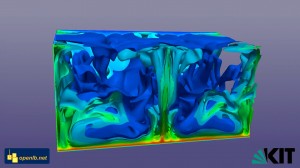 2016/01/03 | OpenLB Community YouTube Channel Update. A new video shows the classic thermal convection benchmark problem of flow and temperature dynamics. The bottom is heated with a small pertubation at the center, at the top a constant lower temperature is applied and at the side the heatflow is assumed to be periodic. You will find this example in our show case section.
2016/01/03 | OpenLB Community YouTube Channel Update. A new video shows the classic thermal convection benchmark problem of flow and temperature dynamics. The bottom is heated with a small pertubation at the center, at the top a constant lower temperature is applied and at the side the heatflow is assumed to be periodic. You will find this example in our show case section.
If you have a nice video which you have obtained with OpenLB, please let us know and we will link it or upload it. Please contact us.
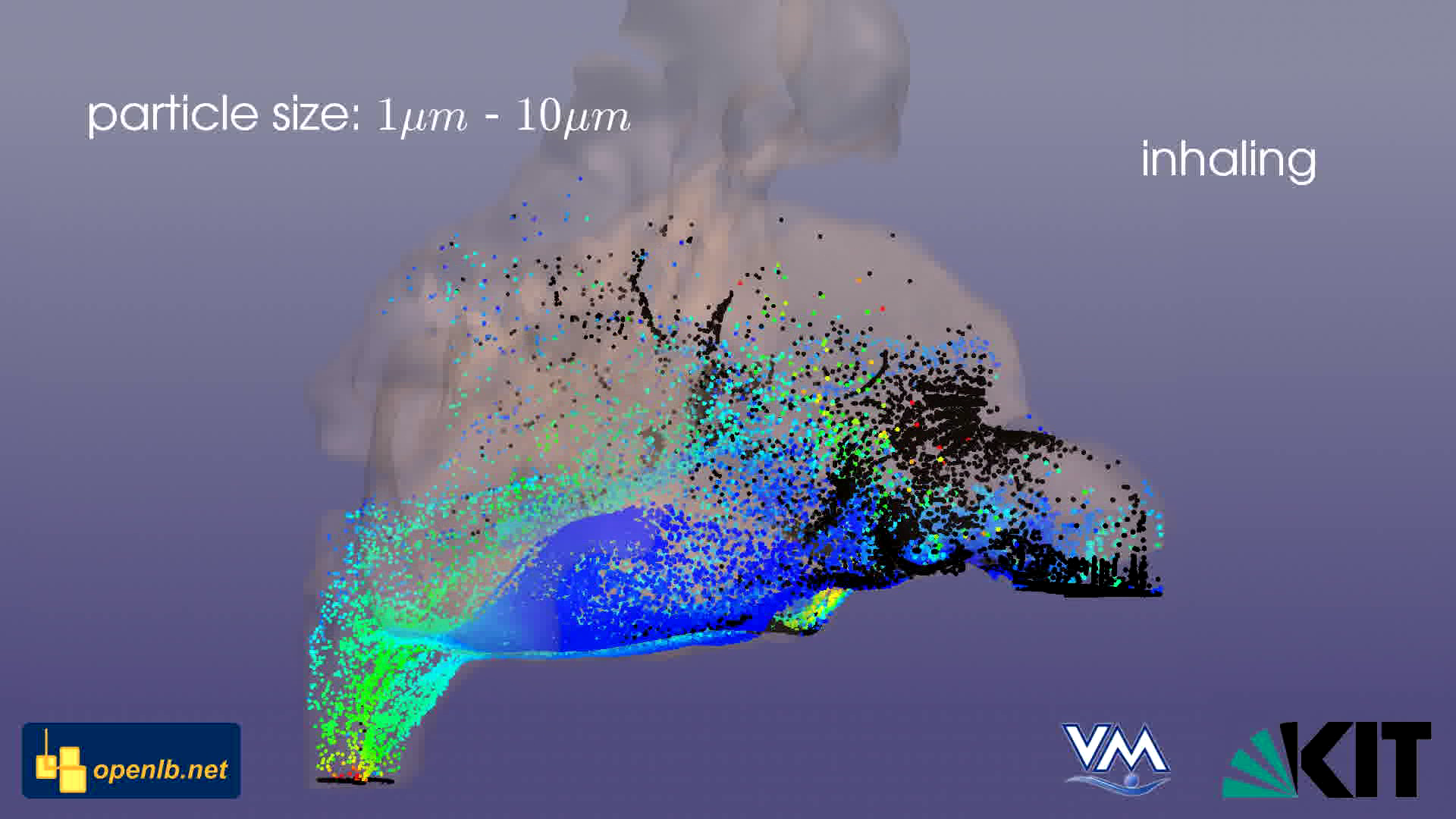 2015/08/01 | OpenLB Community YouTube Channel Update. A new video shows the flow dynamics and particle deposition during respiration in a human nasal cavity, simulated with a DEM-LB model. You will find this example in our show case section.
2015/08/01 | OpenLB Community YouTube Channel Update. A new video shows the flow dynamics and particle deposition during respiration in a human nasal cavity, simulated with a DEM-LB model. You will find this example in our show case section.
If you have a nice video which you have obtained with OpenLB, please let us know and we will link it or upload it. Please contact us.
 2015/03/11 | New Release 0.9 Available. New Release 0.9 Available. The OpenLB developer team is very happy to announce that a new release of the open source Lattice Boltzmann Method (LBM) code is available for download as well as a new user guide and new doxygen documentation. Besides new examples, many innovative and user-friendly interfaces have been added. Have a look and be excited!
2015/03/11 | New Release 0.9 Available. New Release 0.9 Available. The OpenLB developer team is very happy to announce that a new release of the open source Lattice Boltzmann Method (LBM) code is available for download as well as a new user guide and new doxygen documentation. Besides new examples, many innovative and user-friendly interfaces have been added. Have a look and be excited!
The new features and interfaces are:
- User-friendly build-in pre-processing:
- Geometries can be imported as surface mesh from an stl-file as well as created by functors as union, intersection or complement of provided geometry primitives such as cuboids, spheres, cones, cylinders and many more.
- Automatic volume mesh generation and load-balancing for parallel execution.
- Boundary conditions can be set by analytically pre-defined or user-defined functions.
- Advanced parallelization for geometry handling as well as vtk-file output.
- Functor concept further developed, providing new features and enabling a more user-friendly management of pre- and post-processing:
- Indicator functors representing geometrical primitives such as cuboids, spheres, etc., which combined with arithmetic operators allow creation of more complex geometries by union(+), intersection(*) and relative complement(-) of primitives.
- Strain rate, dissipation rate, velocity, pressure … functors deliver results in SI units.
- Flux, drag and lift functors compute integrals over surfaces.
- Norm functors consider convergence in specific norms (cf. poiseuille2d).
- New turbulence models, such as Consistent Strain Smagorinsky.
- New parallel vtk-file output interface for functors.
- All examples updated with a newly developed generic structure helping to set up user-defined examples more easily.
- New examples venturi3d, nozzle3d, phaseSeparationXd illustrating important existing and new features.
- Compatibility tested on Mac, Windows Cygwin, Ubuntu with gcc 4.3.4, 4.7.3, 4.8.2, 4.9.1, 4.9.2 and intel 14.0.4
PS: Please consider to contribute code or join the developer team yourself to strengthen the LB community by sharing your findings in an open and easily reproducible way!
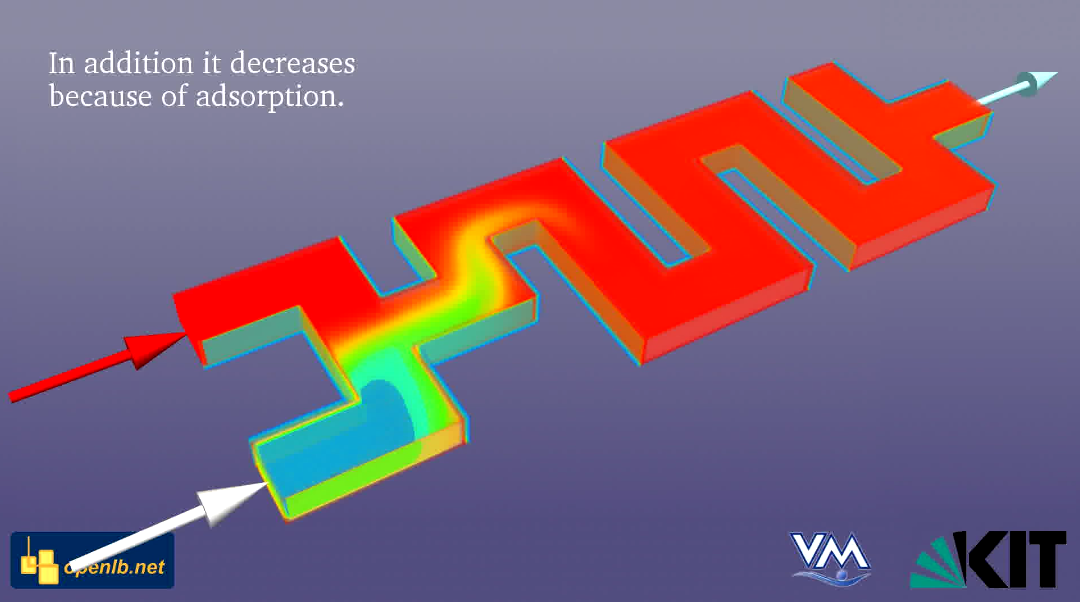 2014/06/26 | OpenLB Community YouTube Channel Update. A new video shows a multi-component flow in a micor mixer, simulated with the a DEM-LB model. You will find this example in our show case section.
2014/06/26 | OpenLB Community YouTube Channel Update. A new video shows a multi-component flow in a micor mixer, simulated with the a DEM-LB model. You will find this example in our show case section.
If you have a nice video which you have obtained with OpenLB, please let us know and we will link it or upload it. Please contact us.
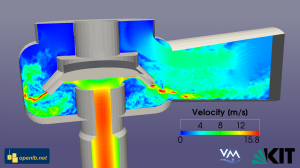 2014/03/20 | OpenLB Community YouTube Channel Update. A new video shows a turbulent flow in a savety valve, simulated with the a Smagorinsky LB model. You will find this example in our show case section.
2014/03/20 | OpenLB Community YouTube Channel Update. A new video shows a turbulent flow in a savety valve, simulated with the a Smagorinsky LB model. You will find this example in our show case section.
If you have a nice video which you have obtained with OpenLB, please let us know and we will link it or upload it. Please contact us.
2013/12/12 | Documentation updated. A new user guide is available as well as new dogygen documentation.
 2013/11/21 | New Release 0.8 Available. New Release 0.8 Available. The OpenLB developer team is very happy to announce that a new release of the open source Lattice Boltzmann Method (LBM) code is from now on available for download. Besides many new features, a lot of new interfaces have been added. Have a look and be excited: you will find OpenLB much more user-friendly. The code have been tested with gcc-4.3.4, gcc-4.6.4, gcc-4.7.3 and intel-12.1.13 compilers. New features are:
2013/11/21 | New Release 0.8 Available. New Release 0.8 Available. The OpenLB developer team is very happy to announce that a new release of the open source Lattice Boltzmann Method (LBM) code is from now on available for download. Besides many new features, a lot of new interfaces have been added. Have a look and be excited: you will find OpenLB much more user-friendly. The code have been tested with gcc-4.3.4, gcc-4.6.4, gcc-4.7.3 and intel-12.1.13 compilers. New features are:
- New model to simulate flows in isotropic porous media (PorousBGKdynamics).
- New model to simulate turbulent flows (SmagorinskyBGKdynamics, smagorinskyMRTdynamics, yPlus functor).
- New model (Bouzidi) for curved boundaries (OffLatticeBoundaryConditions) with automatic assignment from stl-files.
- All examples updated with a newly developed generic structure which will help to set up user-defined examples more easily. The layout now always includes functions for initialization of the lattice and the geometry, the re-setting of boundary values before and during the simulation and the writing of data to the console and to vtk-files.
- Generic Functor concept implemented which includes new features and enables user-friendly handling of pre- and post-processing:
- Indicator functors for geometric objects like cylinders, balls, cuboids and more.
- Analytical functors for a stable and smooth starting of simulations (polynomialStartScale, ..) (cf. examples/cylinder3d).
- Lattice functors for the computation of boundary force, drag force, dissipation, ….
- Lattice functors for the interpolation of computed results on arbitrary positions..
- Collective lattice functors to compute norms (e.g. L1, L2), max, min or averages of arbitrary computed results on a lattice.
- Arithmetic operators (+,-,*,/).
- Generic functor interfaces for vtk-output (cf. examples/cylinder3d).
- Functors for rotating coordinate systems (Coriolis and centrifugal force functors).
- New example (examples/aorta3d) illustrating new features like the Smagorinski model, Bouzidi boundary condition and functors.
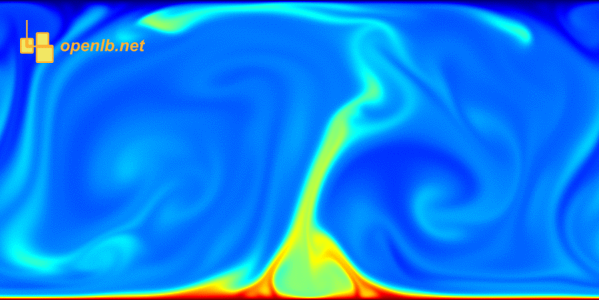 2013/11/19 | OpenLB Community YouTube Channel. A new video shows Rayleigh-Bénard convection in 2D, simulated with the thermal LB model by Z. Guo et al.. In this special case, thermal flow is simulated between a hot plate at the bottom, a cold plate at the top and is assumed to be periodic at the sides. You can find the source code as OpenLB example at “/examples/thermal2d/rayleighBenard2d.cpp”. For this video the parameters Rayleigh=1e+8, Prandtl=1, N=100 (long version: N=300) and dt=0.0001 have been chosen.
2013/11/19 | OpenLB Community YouTube Channel. A new video shows Rayleigh-Bénard convection in 2D, simulated with the thermal LB model by Z. Guo et al.. In this special case, thermal flow is simulated between a hot plate at the bottom, a cold plate at the top and is assumed to be periodic at the sides. You can find the source code as OpenLB example at “/examples/thermal2d/rayleighBenard2d.cpp”. For this video the parameters Rayleigh=1e+8, Prandtl=1, N=100 (long version: N=300) and dt=0.0001 have been chosen.
If you have a nice video which you have obtained with OpenLB, please let us know and we will link it or upload it. Please contact us.
2013/05/10 | The OpenLB Family is Growing. We are happy to welcome our new partners, the “Technische Universität München (Germany)”, “Universidade de São Paulo (Brazil)” and “Changchun Institute of Optics, Fine Mechanics and Physics (China)”. If your organization also wants to participate or you, as a person, want to contribute code, documentation or videos of simulations done with OpenLB, please contact us.
 2012/02/13 | New Release 0.7 Available. A new module allows to analyze the performance of computations and runtime estimations (cf. “examples/cavity2d”). The console output is standardized including sequential and parallel output. Further, a rewritten unit converter enables direct conversion between physical and internal lattice units. The usage of the XML interface is simplified by direct class constructions from XML parameter files, illustrated in “examples/cavity2d”. This example includes also a description file for OpenGPI, which provides a graphical user interface. Finally, the CVMLCPP-library has been updated to ensure compatibility with gcc-4.6.
2012/02/13 | New Release 0.7 Available. A new module allows to analyze the performance of computations and runtime estimations (cf. “examples/cavity2d”). The console output is standardized including sequential and parallel output. Further, a rewritten unit converter enables direct conversion between physical and internal lattice units. The usage of the XML interface is simplified by direct class constructions from XML parameter files, illustrated in “examples/cavity2d”. This example includes also a description file for OpenGPI, which provides a graphical user interface. Finally, the CVMLCPP-library has been updated to ensure compatibility with gcc-4.6.
2012/01/11 | Forum on LBM and OpenLB Added. With the intension to allow discussions on OpenLB and Lattice Boltzmann Methods in general a new forum has been added to the OpenLB-website. Furthermore, a section concerning upcoming conferences and workshops on LBM has been included. This allows organizers to promote their events by informing the community e.g. by a short descriptions and links.
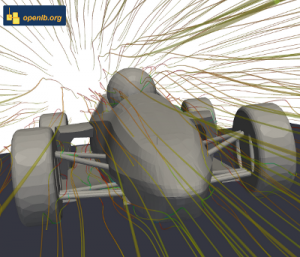 2012/01/10 | On the Way to the Wing Car. In racing, nothing works without innovative concepts and ideas in order to keep up with the competition. In the context of the student design competition “Formula Student” the “Hochschulgruppe” KA-RaceIng in cooperation with the Engineering Mathematics and Computing Lab (EMCL) are developing an aerodynamics package for the new racing car of the Karlsruhe Institute of Technology (KIT). For example in the Formula 1 spoilers and diffusers are already established techniques and with increasing importance an elementary component of competitive vehicles. In the recent seasons of “Formula Student” consideration of the aerodynamics has been introduced in Europe. Using the software OpenLB, which is co-developed at the EMCL, simulation and optimization of the vehicle based on the current model of the KIT12 is carried out. On this basis a new wing packet, consisting of front- and rearwings as well as a diffuser is designed. The findings of the computations can be directly implemented in the constructive process in order to obtain a holistic approach ailored to a 200kg heavy and 100hp strong car. In a first step an underbody has been constructed and simulated, which will be validated on the KIT12 prototype. Based on these results the pending simulation of the wings and the analysis of the entire vehicle will be carried out.
2012/01/10 | On the Way to the Wing Car. In racing, nothing works without innovative concepts and ideas in order to keep up with the competition. In the context of the student design competition “Formula Student” the “Hochschulgruppe” KA-RaceIng in cooperation with the Engineering Mathematics and Computing Lab (EMCL) are developing an aerodynamics package for the new racing car of the Karlsruhe Institute of Technology (KIT). For example in the Formula 1 spoilers and diffusers are already established techniques and with increasing importance an elementary component of competitive vehicles. In the recent seasons of “Formula Student” consideration of the aerodynamics has been introduced in Europe. Using the software OpenLB, which is co-developed at the EMCL, simulation and optimization of the vehicle based on the current model of the KIT12 is carried out. On this basis a new wing packet, consisting of front- and rearwings as well as a diffuser is designed. The findings of the computations can be directly implemented in the constructive process in order to obtain a holistic approach ailored to a 200kg heavy and 100hp strong car. In a first step an underbody has been constructed and simulated, which will be validated on the KIT12 prototype. Based on these results the pending simulation of the wings and the analysis of the entire vehicle will be carried out.
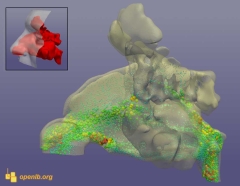 2011/06/22 | Mimics Innovation Awards for Preprocessing Approach Realized in OpenLB. The contribution “A Preprocessing Approach for Innovative Patient-Specific Intranasal Flow Simulations” of Krause (EMCL), Gengenbach (EMCL), Mayer (SCC), Zimny (EMCL) and Heuveline (Head of EMCL) has won the Mimics Innovation Awards 2011 in the category 2 “Innovations in computer aided engineering”. The prize was given for their work related to the international open source project OpenLB and EMCL’s project United Airways. In the paper the researchers present a holistic concept enabling patient-specific airflow simulations in the nasal cavity based on CT data. A proof of conception is provided by means of a case study where advantage is taken of Materialise’s software packages to segment the raw CT data in order to create a 3D model. The meshing, initialization and simulation is automated and realized in the framework of the CFD software package OpenLB.
2011/06/22 | Mimics Innovation Awards for Preprocessing Approach Realized in OpenLB. The contribution “A Preprocessing Approach for Innovative Patient-Specific Intranasal Flow Simulations” of Krause (EMCL), Gengenbach (EMCL), Mayer (SCC), Zimny (EMCL) and Heuveline (Head of EMCL) has won the Mimics Innovation Awards 2011 in the category 2 “Innovations in computer aided engineering”. The prize was given for their work related to the international open source project OpenLB and EMCL’s project United Airways. In the paper the researchers present a holistic concept enabling patient-specific airflow simulations in the nasal cavity based on CT data. A proof of conception is provided by means of a case study where advantage is taken of Materialise’s software packages to segment the raw CT data in order to create a 3D model. The meshing, initialization and simulation is automated and realized in the framework of the CFD software package OpenLB.
 2011/05/11 | New Release 0.6 Available. The new release offers an automated preprocessing with built-in voxelization from stl-files and setting of boundary conditions based on material numbers. The usage is illustrated by the example “examples/cylinder3d”. Further, an XML reader offers an interface for input parameters (cf. “examples/cavity2d”).
2011/05/11 | New Release 0.6 Available. The new release offers an automated preprocessing with built-in voxelization from stl-files and setting of boundary conditions based on material numbers. The usage is illustrated by the example “examples/cylinder3d”. Further, an XML reader offers an interface for input parameters (cf. “examples/cavity2d”).
2010/11/10 | New Team Member Thomas Henn. Thomas Henn joined the OpenLB project. He contributs code for reading STL files, which are surface representations of geometries consisting of triangles, and mesh generation for the use in OpenLB. He integrated CVMLCPP which is a common versatile multi-purpose library for C++. In OpenLB it provides the needed methods for the voxelization.
2010/10/13 | New Team Member Jonas Fietz: Jonas Fietz joined the OpenLB project recently. He contributs code for config file parsing based on XML for the upcoming release. He is also core developer of another open source project called OpenGPI which is a generic parameter interface.
2010/08/20 | Homepage relaunched.
2009/07/27 | Intel Itanium Arward for Parallelization Apraoch Realized in OpenLB. The United Airways project has been awarded from the Itanium Solutions Alliance. The computations were perfomed in parallel using the OpenLB code.
*** Karlsruhe University’s United Airways project in Germany used Itanium-based HP hardware to analyze the interaction of the human nose, sinuses, larynx and lungs with the goal of compiling a complete numerical simulation of flow behavior in the human respiratory system. The end benefits of this project include optimizing asthma sprays, improving the quality of medical operations and understanding the impact of respirable dust. ***

